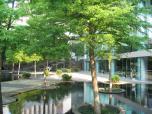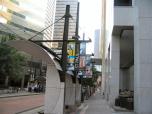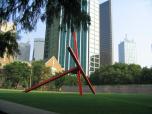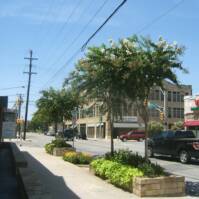









East Dallas is an interesting collage of the old and the new, the rich and the poor, the well-kept and the dilapidated, the black and the white, as well as every racial category in between, the new comer and the well-established, as well as the interesting and the tried and true. While much focus today is rightly on the redevelopment of Oak Cliff and Southern Dallas, or the great future of West Dallas and the Trinity River, it is East Dallas extending from Downtown Dallas out to IH-635, and from Fair Park to Lakewood and City Place where the next twenty years will demonstrate whether Dallas is truly a city for all peoples or whether the city will be a playground for the affluent that is surrounded by intractable blight.
It is not my desire to write prosaically on the matter of life in the near eastern region of Central Dallas, but to draw attention to the fact that it represents in numerous ways, quite a bit about present and future Dallas. I have become more familiar with this area since starting to attend church in it in 2008. Every Sunday morning I would drive from my leafy single family neighborhood nestled between Lake Highlands and Lakewood, past grand older neighborhoods that gradually gave way to old style apartment buildings, dollar stores, immigrant groceries, washeterias and scattered old buildings. It is an area that I have never felt particularly threatened by while spending time in it during the day, (driving around in my car). I will also say that it is an area in which I definitely feel out of place, out of my comfort zone. That being stated, I recognize that it is incumbent upon me and others in the city to recognize that helping areas like this to prosper in their own unique ways, is the key to enabling the urban fabric of Dallas and other cities to continually evolve in a dynamic way for the benefit of everyone.
As I made the regular weekly trip into East Dallas during 2008 and 2009, I became more familiar with a rough geographic area bounded by Ross Avenue, Haskell Avenue, Gaston Avenue and Fitzhugh Avenue. I will call it my Vision Improvement District.
Historical background of East Dallas –One of the most prominent historical figures involved in the settling of East Dallas was William H. Gaston, who came to the area in 1872. Initially only four families settled in that area. However Gaston succeeded in convincing the railroads to travel through East Dallas by giving them $5,000 and free right-of-way through his property. The area became a popular recreation destination for people going from Downtown Dallas to the state fairs. On September 9, 1882, East Dallas was incorporated on 1,400 acres. Some citizens had wanted the town to be named Gaston instead. During the 1880’s, East Dallas was considered the most luxurious place to live in Dallas County with 90 percent of its homes having running water pumped from deep wells by 1889. Some of the earliest traffic calming in Dallas County was imposed here when the city created an 18 mile per hour speed limit to slow down swift horses on the city’s thoroughfares. The first schools were built in 1883, and in 1886, the first all brick school in Dallas County was built, again, in East Dallas. In 1887, the area benefited from the opening of the Texas State Fair and Dallas Exposition at Fair Park opening. By this time, east Dallas had a population of 6,000. On January 1, 1890, the City of East Dallas ceased to exist and became part of Dallas.
The 20th Century witnessed the development and enhancement of Baylor University Medical Center, Dallas Theological Seminary, Criswell College, Fair Park, the Deep Ellum area, Munger Place, Junius Heights, the Swiss Avenue District, and numerous other residential, business and institutional areas.
What in general is in my Vision Improvement District? – There are a number of different institutions, businesses and services within this community. Some of note, include City Church International, Reconciliation Outreach, Emmanuel Lutheran Church, The Dallas Center of Rehabilitation, Welcome House, St. Joseph, Seidler House, and Good Shepherd Community Church,
What have I done in this area? – My involvement in this area included monthly treks to pick up trash of various kinds, to clean up part of that neighborhood in general. The specific focus of this effort was concentrated on San Jacinto Street between Carroll Avenue and Annex Avenue and Holly Avenue between San Jacinto Street and Bryan Street. The rationale behind my efforts was that a cleaner look in the neighborhood in general, would cause others in the neighborhood to take more pride in the appearance of the area. Each month I had different volunteers come down to the neighborhood to assist me in this endeavor. One month in particular a Hispanic gentleman from the neighborhood actually volunteered to help and placed a lot of effort into the clean-up along Holly Avenue. My original plan was to try to motivate others in the neighborhood to join in the effort to clean up their neighborhood each month. The main obstacle I seemed to encounter though, was a perception that inmates, people on work release programs, or people performing court ordered community service typically did this type of work. One positive thing that developed at least for a couple of months was that day laborers who were congregating on a lot near the corner of Carroll Avenue and Ross Avenue actually did a better job of placing their trash in a make-shift container, instead of just letting it litter the lot.
What have others done in this area? – Since its entrance into the community about eight years ago, City Church International has made a profound impact on the lives of children and adults in the area through numerous programs several days out of the week, a Spanish language church service, a bread pantry, and bi-annual outreaches to the neighborhood where sometimes close to 1,000 nearby residents have come through the gate to receive food, clothing, ministry to their children, and prayer for important needs.
Reconciliation Outreach is another major player in this community through its ministry providing both residential and non-residential programs for men, women, and single mothers, who have life-controlling problems such as alcohol, drug abuse, and homelessness.
Welcome House, Inc. serves the community with recovery programs. Since 1966, thousands of multi-racial individuals have been provided services through its programs, and it strives to answer the call of an ever changing community. At present, it focuses on two programs which have been tailored to serve the community in very vital and at risk areas: Project Extended Arms provides shared housing and service for those individuals diagnosed with the HIV/AIDS virus and their families. Operation Renew provides transitional housing and a multitude of recovery support services to educate and assist individuals in recovery from the disease of addiction.
Homeward Bound opened Seidler House in Old East Dallas in 1980 as the first probation-based halfway house in Texas. Most of its residents have a history of alcohol/drug abuse, some have mental health problems and others are homeless and unemployed. Employment placement, counseling, budgeting and developing good work habits are all part of the program. Being drug and alcohol-free while in residence at Seidler House is mandatory
Emanuel Lutheran is a small, century-old congregation near downtown Dallas, that supports English and Spanish ministries, and holds services in both languages.
The Center for Church Planting is a ministry of Good Shepherd Community Church located at 4701 Virginia Avenue in Dallas. Its purpose is to provide training, mentoring, materials, and support for the planting of new local churches in the Dallas Metroplex and beyond.
Who are key players or initiatives outside of this area who can help this area? –Some specific entities of note outside of this area who can have some impact on this area include Baylor University Medical Center, Dallas Theological Seminary, and Criswell College.
Baylor has been effective serving the community through providing free health screenings and tests to men and women. Anyone in the city may take advantage of that, but the fact that Baylor’s main hospital is located in East Dallas provides an opportunity to improve the physical health of those in the neighborhood.
Dallas Theological Seminary is located near this area and it has a number of students who are looking for opportunities to serve the community, some for formal internships, some who desire to provide assistance to less fortunate people. Criswell College, also in this area, is an undergraduate Christian school that also has students who are young who are looking to make a difference in the community.
The Deep Ellum Tax Increment Financing (TIF) District is a little ways away from this area as it primarily encompasses an area south and west of Baylor University Medical Center. However, improvements that occur in this area can help a domino effect to occur that can move toward the fringes of this community. It is located between downtown Dallas and Fair Park within walking distance from the Dallas Farmer’s Market, the Arts District, and Baylor Hospital. The District was created in 2005 to enhance the real estate market and encourage new investment by providing a source of funding for public amenities and infrastructure improvements. The district will expire in 2027.
Deep Ellum Public Improvement District was established in 1999 and renewed in 2006. The Deep Ellum area consists of approximately 427 properties and is a combination of business, residential, public and light industrial uses. Deep Ellum Foundation manages the PID. The general nature of the service and improvements provided by the PID are to enhance security and public safety, maintenance, marketing and promotion, funding for long range planning for capital projects and other services and activities approved by the Dallas City Council.
There is also a plan to study how the Gaston Avenue Corridor can be enhanced from Downtown Dallas to Garland Road, bearing in mind that much of the infrastructure in that area is quite old. Many of the communities have gradually improved during the past thirty years, but there is still much work to be done to enable Gaston Avenue to be the gateway it needs to be from the Lakewood area into Downtown.
Governmental players in this area – These include at least two public elementary schools, Cesar Chavez, and James W. Fannin. The Dallas Independent School District representatives for this area include Adam Medrano, and Mike Morath…..The Dallas City Council representative for this area is Pauline Medrano. The Texas State House of Representatives for this area is Dan Branch. The Texas State Senator for this area is Royce West The US Congress House representative is Eddie Bernice Johnson, and the Senators are Kay Baily Hutchinson and John Cornyn.
The Crossroads to the World
Posted: August 1, 2012 by Chuck DeShazo
